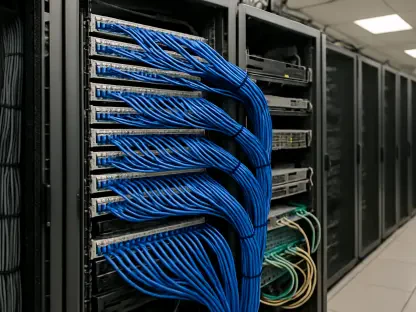The article “Cybersecurity Is at the Heart of the Army’s Network Plan” delves into the significant advances within the U.S. Army’s network infrastructure. The comprehensive modernization strategy focuses keenly on integrating zero-trust cybersecurity principles to ensure resilience and efficacy in support of multidomain operations globally. This initiative is essential to prepare the Army for near-peer or peer competitors, enhancing the survivability and efficacy of the network in diverse operational settings. The program’s success will necessitate constant vigilance and evolution in cybersecurity measures to meet the ever-changing threats posed by sophisticated adversaries.
The goal is to create a data-centric, resilient network that can withstand the pressures of modern warfare. By focusing on zero-trust principles, the Army is ensuring that every user and device within the network is continuously validated before access to data is granted. This strategy is critical given the growing sophistication of cyber threats, necessitating robust data and service protection at all levels. This approach ensures the network maintains operational superiority regardless of the environment. The Unified Network Plan 2.0, released on March 4, emphasizes the integration of tactical, strategic, and enterprise networks to support rapid deployments and adaptability in global theaters.
The Unified Network Plan 2.0
Released on March 4, the Unified Network Plan 2.0 outlines the Army’s approach to constructing a data-centric, resilient network capable of handling near-peer and peer competitors. Central to the plan is the integration of common operating environments, services infrastructure, and transport layers to achieve a truly unified network. This integration spans tactical, strategic, and enterprise networks, ensuring seamless operations and enabling rapid deployments globally. By holistically addressing the different network layers, the Army aims to create a cohesive and adaptable network infrastructure.
The adoption of zero-trust principles within the cybersecurity framework forms the foundation of this endeavor. These measures guarantee robust data and service protection across all levels, addressing the growing complexity of cybersecurity threats in modern warfare. Zero-trust requires continuous verification, segmenting network access, and minimizing the risk of lateral movements by potential adversaries once inside the network. The integrated approach allows for a resilient and secure network capable of performing in diverse and challenging operational settings.
Conceptual Origins and Strategic Importance
The Unified Network Plan 2.0 traces back to a vision from 2017 by then-Maj. Gen. James Mingus. Today, Gen. Mingus, along with retired Lt. Gen. John Morrison, acknowledges that previous network models would not survive sophisticated threats from advanced adversaries. Morrison emphasizes the necessity of a secure, layered network managed by dedicated cyber teams to ensure swift and effective transmission of information critical to operational success. The vision for a resilient network underscores the need to be proactive and forward-thinking in addressing emerging cyber threats.
The network modernization plan targets a force design adept at thriving in compromised environments—denied, disrupted, intermittent, and limited settings. This objective reflects the overarching need for adaptability and operational agility. Ensuring the network is capable of maintaining functionality despite adversarial attempts to disrupt operations is crucial. This adaptability is essential for the Army to effectively operate in complex and contested environments, providing the strategic and tactical advantages required for mission success.
Phased Implementation Strategy
The plan’s execution follows a phased roadmap, with Phase I scheduled for completion by 2026. This initial phase involves setting up the Army’s segment of the DoD Information Network, enhancing hybrid computing capabilities, and fostering a persistent mission partner environment (MPE). The aim is to integrate joint operational efforts with compatible technology and skilled personnel. Establishing a common framework ensures seamless collaboration across different branches and allied forces, enhancing overall mission effectiveness.
Phase II, commencing in 2027, advances continuous modernization and the integration of cutting-edge technologies like quantum-resistant encryption and mission-centric AI and ML. Divesting legacy systems and adopting new innovations will ensure the network evolves parallel to advancements in cybersecurity. These emerging technologies will provide enhanced capabilities for data processing, threat detection, and automated responses to cyber incidents. The ongoing adoption of advanced technologies will ensure that the Army’s network remains at the forefront of cybersecurity and operational efficiency.
Continuous Modernization Efforts
The Army recognizes that modernization is a continuous process with no absolute endpoint. This understanding is crucial as the rapid evolution of information technology demands perpetual improvements to preserve operational superiority. Phase II will involve integrating dynamic transport systems, robust computing, and edge sensors to enhance performance in contested environments. The continuous upgrade of network components and capabilities ensures the Army can respond proactively to new threats and operational challenges.
Dan Driscoll, the new Secretary of the Army, emphasizes preparing the Army to excel amidst evolving modern threats. His priority focuses on equipping soldiers with optimal training, resources, and leadership to secure mission success and bolster the force’s lethality. By fostering a culture of continuous improvement and innovation, the Army ensures that its personnel are always prepared to meet the demands of modern warfare. The commitment to ongoing modernization is key to maintaining a competitive edge in a rapidly changing technological landscape.
Industry Collaboration Opportunities
The article “Cybersecurity Is at the Heart of the Army’s Network Plan” explores significant advancements in the U.S. Army’s network infrastructure. The modernization strategy emphasizes integrating zero-trust cybersecurity principles to ensure resilience and efficacy, supporting global multidomain operations. This initiative is crucial for preparing the Army against near-peer or peer competitors, enhancing network survivability and effectiveness in various operational settings. Success will demand constant vigilance and evolution in cybersecurity measures to counter sophisticated threats.
The objective is a data-centric, resilient network capable of handling modern warfare pressures. By implementing zero-trust principles, the Army guarantees continuous validation of every user and device before granting data access. This strategy is vital considering the increasing sophistication of cyber threats, requiring robust data and service protection at all levels to maintain operational superiority. The Unified Network Plan 2.0, released on March 4, stresses the integration of tactical, strategic, and enterprise networks to support rapid deployments and adaptability in global theaters.









